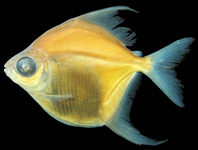Abstract
Cambarus polypilosus sp. nov. is a stream-dwelling crayfish endemic to tributaries in the Buffalo and lower Duck River drainage, and a reach of the lower Tennessee River in the Western Highland Rim of West-Central Tennessee, U.S.A. The new species is closely allied to the three members of the former subgenus Glareocola, but can be differentiated from each by a combination of characters, including body size, coloration, spination, setation, and form I male gonopod morphology. Several meristic measurements and ratios also differentiate C. polypilosus sp. nov. from Cambarus friaufi, to which it is morphologically most similar. Cambarus polypilosus sp. nov. appears to be common in cherty gravel and cobble habitats, where it is typically found in interstices at depths of 0.3 m or more below the substrate surface.
References
Ahlstedt, S.A., Powell, J.R., Butler, R.S., Fagg, M.T., Hubbs, D.W., Novak, S.F., Palmer, S.R. & Johnson, P.D. (2017) Historical and current examination of freshwater mussels (Bivalvia: Margaritiferidae: Unionidae) in the Duck River Basin Tennessee, U.S.A. Malacological Review, 45, 1–163.
Bouchard, R.W. & Bouchard, J.W. (1995) Two new species and subgenera (Cambarus and Orconectes) of crayfishes (Decapoda: Cambaridae) from the Eastern United States. Notulae Naturae, 471, 1–21.
Breinholt, J.W., Porter, M.L. & Crandall, K.A. (2012) Testing phylogenetic hypotheses of the subgenera of the freshwater crayfish genus Cambarus (Decapoda: Cambaridae). PLoS ONE, 7, e46105.
https://doi.org/10.1371/journal.pone.0046105Crandall, K.A. & De Grave, S. (2017) An updated classification of the freshwater crayfishes (Decapoda: Astacidea) of the world, with a complete species list. Journal of Crustacean Biology, 37 (5), 615–653.
https://doi.org/10.1093/jcbiol/rux070Crandall, K.A. & Fitzpatrick, J.F. Jr. (1996) Crayfish molecular systematics: Using a combination of procedures to estimate phylogeny. Systematic Biology, 45, 1–26.
https://doi.org/10.1093/sysbio/45.1.1Fetzner, J.W. Jr. (1996) Biochemical systematics and evolution of the crayfish genus Orconectes (Decapoda: Cambaridae). Journal of Crustacean Biology, 16, 111–141.
https://doi.org/10.1163/193724096X00333Hobbs, H.H. Jr. (1953) Two new crayfishes from the Highland Rim in Tennessee (Decapoda, Astacidae). Journal of the Tennessee Academy of Science, 28, 20–27.
IUCN (2001) Categories & Criteria (version 3.1). Available from: http://www.iucnredlist.org/static/categories_criteria_3_1 (accessed 21 February 2018)
Hothorn, T., Hornik, K., van de Wiel, M. & & Zeileis, A. (2006) A Lego System for Conditional Inference. The American Statistician, 60 (3), 257–263.
https://doi.org/10.1198/000313006X118430Loughman, Z.J., Welsh, S.A. & Thoma, R.F. (2017) Cambarus appalachiensis, a new species of crayfish (Decapoda: Cambaridae) from the New River Basin of Virginia and West Virginia. Zootaxa, 4243 (3), 1–23.
https://doi.org/10.11646/zootaxa.4243.3.2Master, L. (1991) Assessing threats and setting priorities for conservation. Conservation Biology, 5, 559–563.
https://doi.org/10.1111/j.1523-1739.1991.tb00370.xNear, T.J., Simmons, J.W., Mollish, J.M., Correa, M.A., Benavides, E., Harrington, R.C. & Keck, B.P. (2017) A new species of logperch endemic to Tennessee (Percidae: Etheostomatinae: Percina). Bulletin of the Peabody Museum of Natural History, 58 (2), 287–308.
https://doi.org/10.3374/014.058.0203Manly, B. (2006) Randomization, Bootstrap and Monte Carlo Methods in Biology. 3rd Edition. Chapman and Hall/CRC, Boca Raton, FL, 480 pp.
Oksanen, J., Blanchet, F., Friendly, M., Kindt, R., Legendre, P., McGlinn, D., Minchin, P.R., O'Hara, R.B., Simpson, G.L., Solymos, P., Henry, M., Stevens, H., Szoecs, E. & Wagner, H. (2017) vegan: Community Ecology Package. R package version 2.4-4. Available from: https://CRAN.R-project.org/package=vegan (accessed 21 February 2018)
Ortmann, A.E. (1924) The naiad-fauna of Duck River in Tennessee. The American Midland Naturalist, 9 (1), 18–62.
https://doi.org/10.2307/2993214Potvin, C. & Roff, D. (1993, September) Distribution-Free and Robust Statistical Methods: Viable Alternatives to Parametric Statistics. Ecology, 74 (6), 1617–1628.
https://doi.org/10.2307/1939920R Core Team (2017) R: A language and environment for statistical computing. R Foundation for Statistical Computing, Vienna, Austria. Available from: https://www.R-project.org/ (accessed 21 February 2018)
Stern, D.B., Breinholt, J., Pedraza-Lara, C., López-Mejía, M., Owen, C.L., Bracken-Grissom, H., Fetzner, J.W. Jr. & Crandall, K.A. (2017) Phylogenetic evidence from freshwater crayfishes that cave adaptation is not an evolutionary dead-end. Evolution, 71–10, 2522–2532.
https://doi.org/10.1111/evo.13326Taylor, C.A. & Knouft, J.H. (2006) Historical influences on genital morphology among sympatric species: gonopod evolution and reproductive isolation in the crayfish genus Orconectes (Cambaridae). Biological Journal of the Linnean Society, 89, 1–12.
https://doi.org/10.1111/j.1095-8312.2006.00637.xTaylor, C.A., Schuster, G.A., Cooper, J.E., Distefano, R.J., Eversole, A.G., Hamr, P., Hobbs III. H.H., Robison, H.W., Skelton, C.E. & Thoma, R.F. (2007) Reassessment of the conservation status of crayfishes of the United States and Canada after 10+ years of increased awareness. Fisheries, 32, 372–389.
https://doi.org/10.1577/1548-8446(2007)32[372:AROTCS]2.0.CO;2

